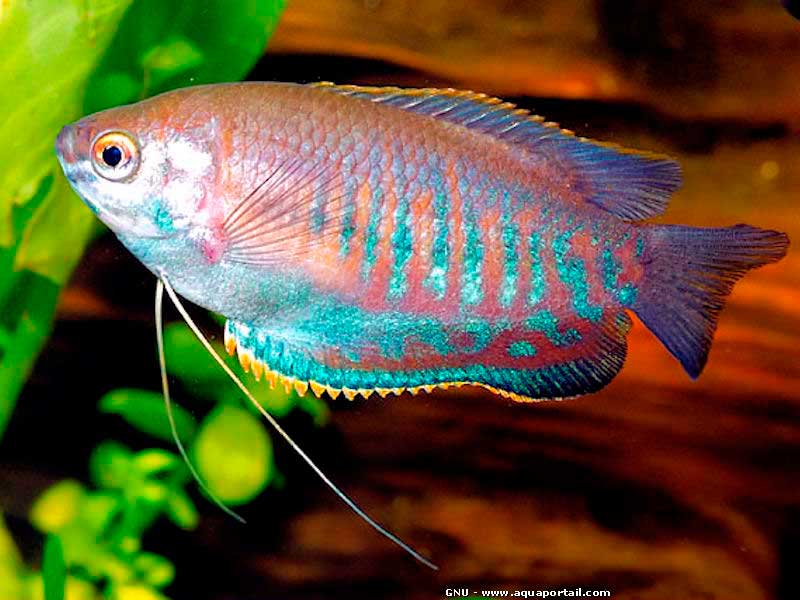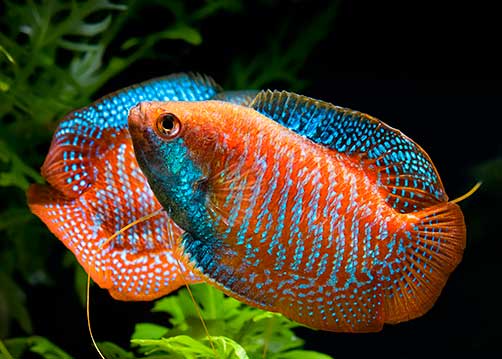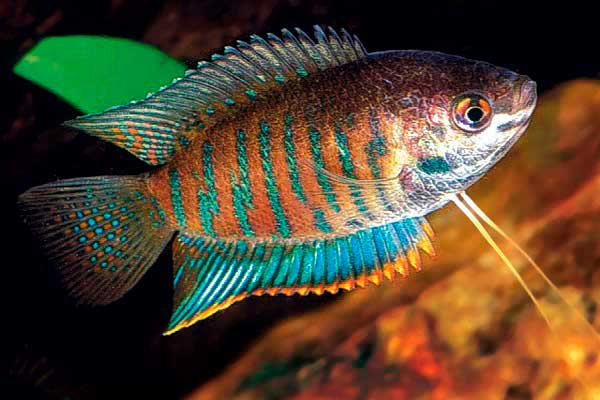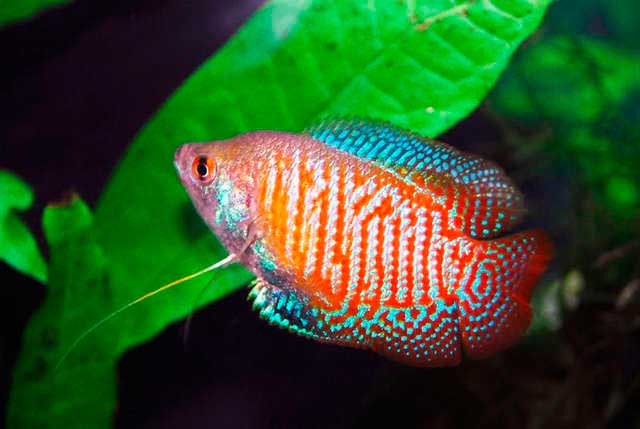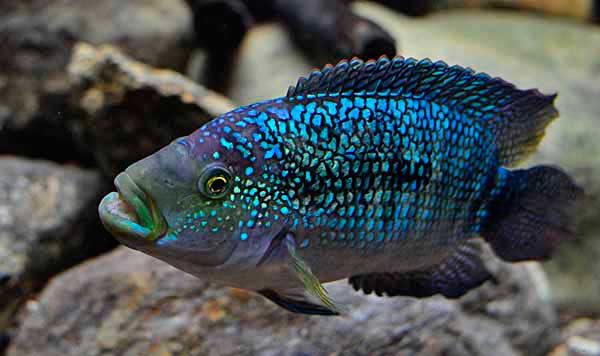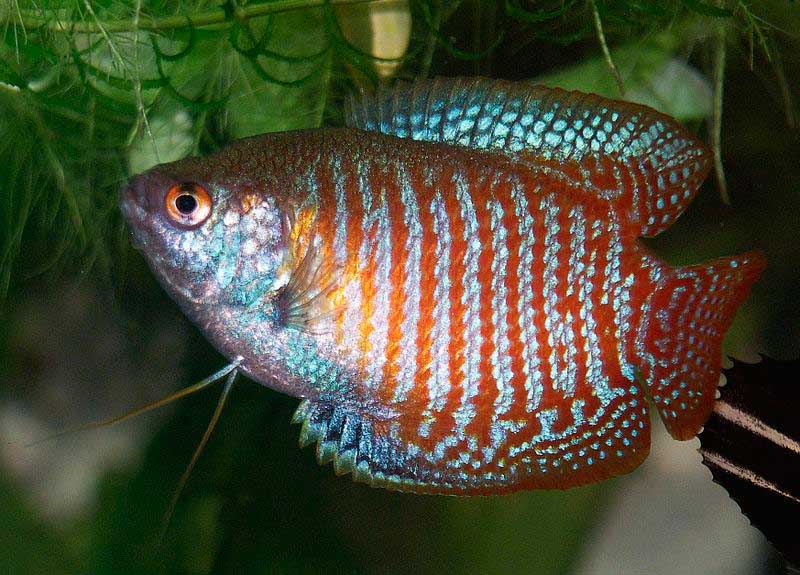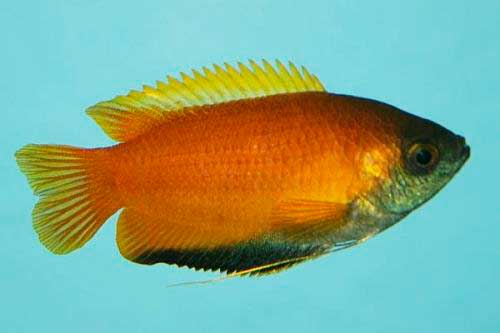Colisa labiosa is a very graceful fish, as well as other members of the genus are known to aquarists around the world for more than a hundred years. Lyabiosa is probably the largest of the colizae. Its coloration resembles the coloration of lalius. However, unlike its smaller counterpart, this fish is more peaceful, despite its impressive by aquarium standards of size.
- Domain: Eukaryotes
- kingdom: Animals
- Type: Chordates
- Class: Radial fish
- Squad: Perch
- Family: Macropods
- Rod: Colisa
- View: Labiosa
Earlier it has already been indicated that ichthyologists have disbanded the genus Coliza and attribute species that once made up this genus to other genera and families. Now labyosa belongs to the genus Trichogaster and its full name is now Trichogaster labiosus. Nevertheless, this does not detract from the beauty of these fish, and they are still of interest to the creators of home artificial lakes.
Colisa labyosa was first described by Dey in 1878. It was first introduced to Europe in 1904. However, it did not become widespread at that time.
Widespread among aquarists in Europe, the fish received in 1911 when they began their mass importation from Rangoon. The native range of labyosa is lower and upper Burma, India, where the fish inhabits mainly the basin of the Irrawaddy River.
Colisa labiosa Description of species
Lyabiosa, as mentioned above is the largest representative of the genus Coliza. In the wild, these fish reach sizes up to 10 centimeters in length. Behind the glass of the aquarium its size rarely exceeds 7 centimeters. Its body is flattened from the sides, high enough. The main color of the body is blue, it is streaked with 8 to ten vertical stripes of red-brick color. A black stripe passes through the eye, giving the impression of a thickening of the upper lip. For this visual illusion labyosa in Europe is sometimes called lip gourami.
Unpaired fins have a basic color – olive. The upper edge of the dorsal fin has a red border. The end of this fin in the male is pointed. In addition to this sign of sexual dimorphism in males whiskers – modified pelvic fins are colored red, in females they are yellow. The lower part of the head and abdomen shimmer green-blue shades.
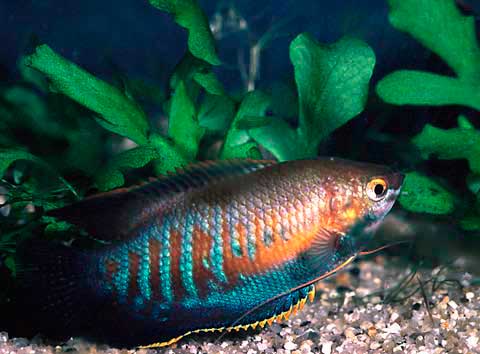
To keep a pair of these fish is suitable capacity of 25-30 liters. However, labyosis can safely be kept in a common aquarium.
Compatibility
Despite their size, they are creatures of peace and do not offend even the smallest fish. True, picking up their neighbors it is desirable to pick up fish are not aggressive and not too impetuous. Lyabiosa creature is not only peaceful, but also fearful. In addition, barbs will be them also bad neighbors.
These varmints are not indifferent, for some reason to the long veil fins and norerovat them all the time to pinch. In labyosa although there are no veil fins, but there are whiskers, which also will not leave the barbs indifferent. They will make not a little effort to pinch this from their point of view useless for the right fish accessory. Over time, such an overbitten mustache will heal, but will have a broken distorted appearance.
To the ground, as well as the majority of coliseums labyosa is indifferent, so you can use any you like. Take into account only that on a dark background fish look more spectacular. However, it is a matter of taste.
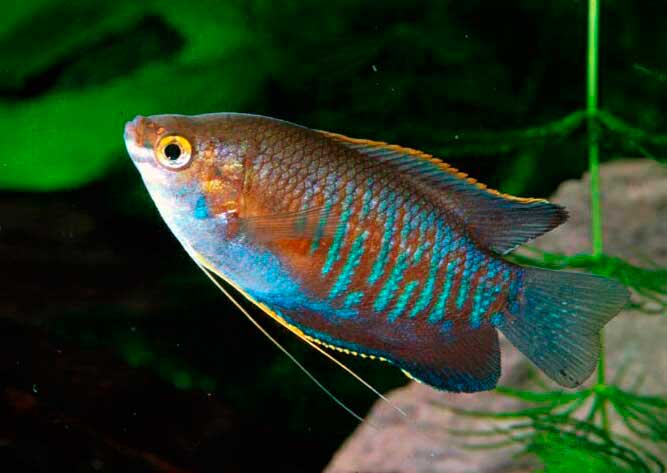
Plants for aquarium decoration
Plants can be used in a variety of ways. Taking into account the fearfulness of the heroes of our today’s story, it is desirable that the plants form relatively dense thickets, in which these cowards could sit out the danger real or imaginary.
It is quite possible to use valisneria, elodea, cattail for landscaping. For fans of more exotic plants can try to put in the aquarium some species of cryptocoryne. Plants floating on the surface of the water are not mandatory. Lyabioses do not use them when building a nest.
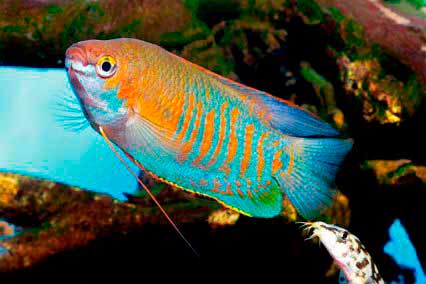
Colisa labiosa like bright light. It is desirable that several hours a day the aquarium should be illuminated by sunlight. The water temperature should not be lower than 26 degrees Celsius. The aquarium should preferably be covered with glass to prevent cold air from entering the overwater. These fish are labyrinthine and ingestion of cold air can lead to disease.
Colisa labiosa necrosis
Spawning occurs most often in spring. In most cases, no special preparation is required. When the male deems it necessary, he will begin to build a foam nest, characteristic of all labyrinth fish. During this period, the cold air is the most dangerous for the future daddy. When building a nest, he has to swallow a large amount of air, which he then spits out in the form of bubbles, of which the nest actually consists. Plants are not used to build the nest. The nest is therefore fragile and vague, like a gourami’s.
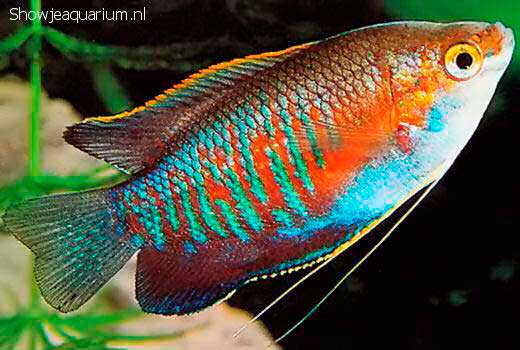
When the nest is ready, the fish are located under it and spawning begins. The female for one spawning can throw out up to one and a half thousand small eggs. After all the eggs will be hatched female should be removed, believing the care of the offspring to the father of the family.
Incubation lasts from 36 to 48 hours depending on the thermal regime. After another five to six days, the fry will swim and start feeding. It is desirable not to miss this moment. The male should be removed and start feeding the fry. Recommendations for feeding general. Of the peculiarities can perhaps say that despite the rather large size of adult fish their fry are very small, and you can feed them only live dust or rotifers. While the extraction of these live feeds will be conducted, you can try to feed the young home culture of infusoria. In the most extreme case, you can use artificial feed – the yolk of hard-boiled eggs, milk or egg powder. But the results in this case will be much worse.
Conclusion
The only thing left to add is that colisa labyosa is much less common behind aquarium glass now than it used to be. In my opinion, this is an unfortunate misunderstanding. These fish are so beautiful and relatively unpretentious that they can be recommended to novice aquarists. And their peaceful disposition allows you to keep them in a common aquarium, eliminating the need to equip a separate home for them. I hope you liked this fish and if you meet it at the zoo market, you will definitely buy.
